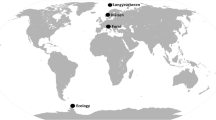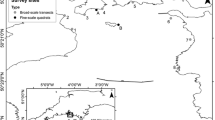Abstract
Previous studies on the rocky intertidal shores of the Bay of Panama indicate that for many sessile and mobile organisms holes and crevices are important refuges from consumers. To study the dynamics of these hole-dwelling species assemblages, we devised a method allowing repetitive, non-destructive sampling and species manipulations in artificial holes. These are fiberglass sleeves with flanges at the outer edge that are inserted into receptacles made of quick-setting concrete. Predator and herbivore manipulations include: fences excluding slow-moving benthic consumers, bars across hole mouths restricting entry of large fishes and homogeneous (shelterless) surfaces created around a treatment decreasing abundance of small crabs. This design has withstood the rigors of two wet seasons in Panama. Results from two sites in Panama indicate that colonization occurs rapidly (6–7 months) in holes established in mid dry season. Encrusting fleshy algae (Ralfsia sp.) and ephemeral green algae (Cladophora spp.) colonize first and are succeeded by encrusting species of coralline algae, bryozoans and colonial tunicates and by erect fleshy red algae. Where consumers are present, encrusting corallines predominate; without consumers, bryozoans, tunicates and erect algae are more abundant. Zonation patterns develop within the holes, with the desiccation/heattolerant Ralfsia sp. dominating at the outer edges. With increasing deph, encrusting coralline algae, bryozoans and colonial tunicates reach their respective peak abundances. In contrast to the high variability observed among naturally occurring holes, replicates of each treatment tend to be similar. Between-treatment and between-site comparisons are less so. The naturally-occurring high level of small-scale patchiness is thus presumably due to variation in recruitment and in the local (microspatial) consumer regime. Substratum heterogeneity is therefore directly and indirectly important in maintaining a high local diversity in this community. As in other studies, consumers or disturbances are key factors in regulating patterns of community structure. More experiments of longer duration are necessary to ascertain the relative importances of consumers/disturbance and competition in controlling such assemblages.
Similar content being viewed by others
Literature cited
Bernstein, B. B., B. E. Williams and K. H. Mann: The role of behavioral responses to predators in modifying urchins' (Strongylocentrotus droebachiensis) destructive grazing and seasonal foraging patterns. Mar. Biol. 63, 39–49 (1981)
Bertness, M. D., S. D. Garrity and S. C. Levings: Predation presure and gastropod foraging: a tropical-temperate comparison. Evolution 35, 995–1007 (1981)
Buss, L. W., and J. B. C. Jackson: Competitive networks: non-transitive competitive relationships in cryptic coral reef environments. Am. Nat. 113, 223–234 (1979)
Buss, L. W. and J. B. C. Jackson: Planktonic food availability and suspension-feeder abundance: evidence of in situ depletion. J. exp. mar. Biol. Ecol. 49, 151–161 (1981)
Connell, J. H.: A predator-prey system in the marine intertidal region. I. Balanus glandula and several predatory species of Thais. Ecol. Monogr. 40, 49–78 (1970)
Connell, J. H. and R. O. Slatyer: Mechanisms of succession in natural communities and their role in community stability and organization. Am. Nat. 111, 1119–1144 (1977)
Dayton, P. K.: Competition, disturbance and community organization: the provision and subsequent utilization of space in a rocky intertidal community. Ecol. Monogr. 41, 351–389 (1971)
Duggins, D. O.: Kelp beds and sea otters: an experimental approach. Ecology 61, 447–453 (1980)
Gaines, S. D.: Diverse consumer guilds in the intertidal communities of Oregon and the Republic of Panama and their effects on prey assemblages. Ph. D. thesis, 125 pp. 1982
Gaines, S. D. and J. Lubchenco: A unified approach to marine plant-herbivore interactions. II. Biogeography. Ann. Rev. Ecol. Syst. 13, 111–138 (1982)
Glynn, P. W., G. M. Wellington and C. Birkeland: Coral reef growth in the Galapagos: limitation by sea urchins. Science, N.Y. 203, 47–49 (1979)
Hay, M. E.: The functional morphology of turf-forming seaweeds: persistence in stressful marine habitats. Ecology 62, 739–750 (1981)
Holbrook, S. J.: Habitat utilization, competitive interactions, and coexistence of three species of cricetine rodents in East-Central Arizona. Ecology 60, 758–769 (1979)
Jackson, J. B. C.: The ecology of the molluscs of Thalassia communities, Jamaica, West Indies II. Molluscan population variability along an environmental stress gradient. Mar. Biol. 14, 304–337 (1972)
Jackson, J.B.C.: Competition on marine hard substrata: the adaptive significance of solitary and colonial strategies. Am. Nat. 111, 743–767 (1977)
Jackson, J. B. C.: Overgrowth competition between encrusting cheilostome exctoprocts in a Jamaican cryptic reef environment. J. Anim. Ecol. 48, 806–823 (1979)
Jackson, J. B. C. and L. W. Buss: Allelopathy and spatial competition among coral reef invertebrates. Proc. nat. Acad. Sci. US 72, 5160–5163 (1975)
Jackson, J. B. C. and J. E. Winston: Ecology of cryptic coral reef communities. I. Distribution and abundance of major groups of encrusting organisms. J. exp. mar. Biol. Ecol. 57, 135–147 (1982)
Keen, S. L. and W. E. Neill: Spatial relationships and some structuring processes in benthic intertidal animal communities. J. exp. mar. Biol. Ecol. 45, 139–155 (1980)
Kensler, C. B. and D. J. Crisp: The colonization of artificial crevices by marine invertebrates. J. Anim. Ecol. 34, 507–516 (1965)
Kohn, A. J.: Environmental complexity and species diversity in the gastropod genus Conus on Indo-West Pacific reef platforms. Am. Nat. 101, 251–259 (1967)
Lessios, H.: Reproductive periodicity of the echinoids Diadema and Echinometra on the two coasts of Panama. J. exp. mar. Biol. Ecol. 50, 47–61 (1981)
Lubchenco, J.: Plant species diversity in a marine intertidal community: importance of herbivore food preference and algal competitive abilities. Am. Nat. 112, 23–39 (1978)
Lubchenco, J. and B. A. Menge: Community development and persistence in a low rocky intertidal zone. Ecol. Monogr. 59, 67–94 (1978)
Lubchenco, J., B. A. Menge, S. D. Garrity, P. J. Lubchenco, L. R. Ashkenas, S. D. Gaines, R. Emlet, J. Lucas and S. Strauss: Structure, persistence and role of consumers in a tropical rocky intertidal community (Taboguilla Island, Bay of Panama). J. exp. mar. Biol. Ecol. (In press)
Mann, K. H. and P. A. Breen: The relation between lobster abundance, sea urchins and kelp beds. J. Fish. Res. Bd Can. 29, 603–609 (1972)
MacArthur, R. H. and J. W. MacArthur: On bird species diversity. Ecology 42, 594–598 (1961)
Menge, B. A.: Organization of the new England rocky intertidal community: role of predation, competition, and environmental heterogeneity. Ecol. Monogr. 45, 355–393 (1976)
Menge, B. A., and J. Lubchenco: Community organization in temperate and tropical rocky intertidal habitats: prey refuges in relation to consumer pressure gradients. Ecol. Monogr. 51, 429–450 (1981)
Paine, R. T. and R. L. Vadas: The effects of grazing by sea urchins, Strongylocentrotus spp. on benthic algal populations. Limnol. Oceanogr. 14, 710–719 (1969)
Peterson, C. H.: The importance of predation and competition in organizing the intertidal epifaunal communities of Barnegat Inlet, New Jersey. Oecologia 39, 1–24 (1979)
Pianka, E. R.: Lizard species diversity. Ecology 48, 333–351 (1967)
Price, M. V.: The role of microhabitat in structuring desert rodent communities. Ecology 59, 910–921 (1978)
Russ, G. R.: Effects of predation by fishes, competition, and structure complexity of the substratum on the establishment of a marine epifaunal community. J. exp. mar. Biol. Ecol. 42, 55–59 (1980)
Russ, G. R.: Overgrowth in a marine epifaunal community: competitive hierarchies and competitive networks. Oecologia 52, 12–19 (1982)
Sokal, R. R. and F. J. Rohlf: Biometry. 2nd Edition, 859 pp. San Francisco: W. H. Freeman and Co. 1981
Southwood, T. R. E.: Ecological methods with particular reference to the study of insect populations, 391 pp. London: Methuen and Co., Ltd. 1966
Steneck, R. W.: A limpet-coralline alga association: adaptations and defenses between a selective herbivore and its prey. Ecology 63, 507–522 (1982)
Whittaker, R. H.: Communities and ecosystems, 162 pp., New York: MacMillan Publ. Co. 1975
Woodin, S. A.: Refuges, disturbance, and community structure: a marine soft-bottom example. Ecology 59, 274–284 (1978)
Woodin, S. A.: Disturbance and community structure in a shallow water sand flat. Ecology 62, 1052–1066 (1981)
Author information
Authors and Affiliations
Additional information
Communicated by O. Kinne, Hamburg
Rights and permissions
About this article
Cite this article
Menge, B.A., Ashkenas, L.R. & Matson, A. Use of artificial holes in studying community development in cryptic marine habitats in a tropical rocky intertidal region. Mar. Biol. 77, 129–142 (1983). https://doi.org/10.1007/BF00396310
Accepted:
Issue Date:
DOI: https://doi.org/10.1007/BF00396310




